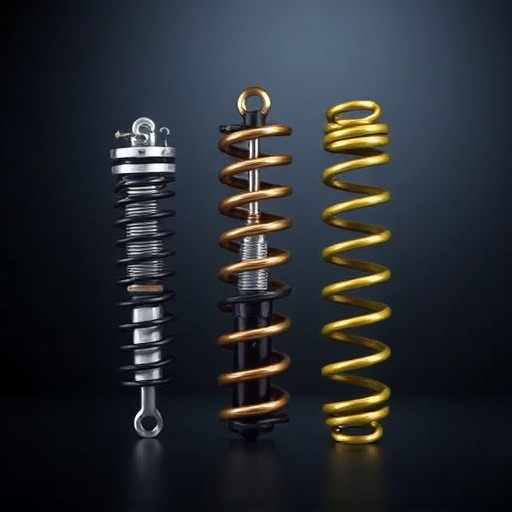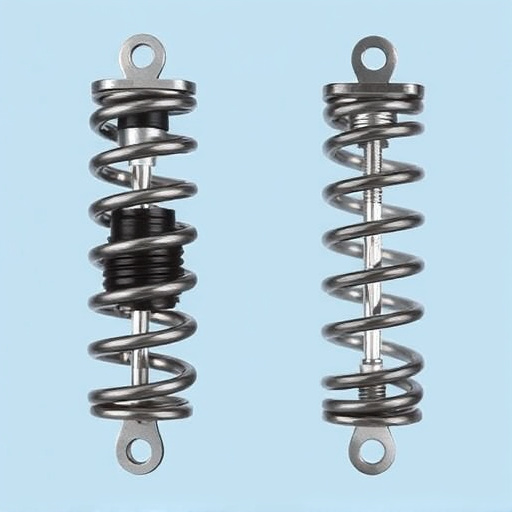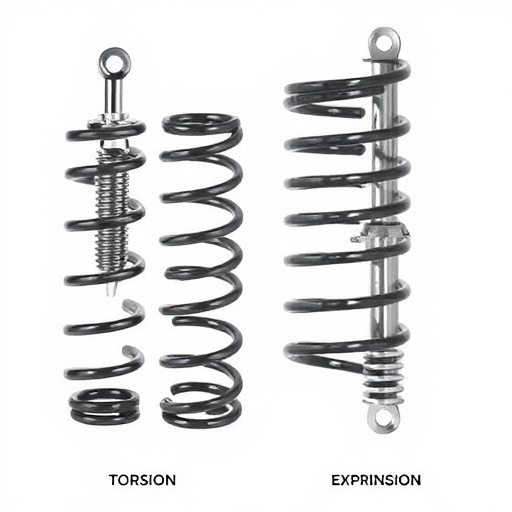Spring repairs vary with torsion and extension springs. Torsion springs twist for controlled movements, while extension springs stretch under tension. Their failure modes differ, affecting steering or ride quality. Regular maintenance, including inspections, is key for both types. Choosing correct springs from local suppliers ensures optimal vehicle performance and safety. Understanding the difference between torsion and extension springs explained is crucial for effective automotive care.
Need expert spring repairs for your vehicle? Whether it’s a classic car or a modern SUV, proper spring maintenance is crucial for safety and performance. This guide delves into the intricacies of understanding torsion vs. extension springs—key differences that impact handling and durability. We’ll help you diagnose common spring issues, explore advanced repair techniques, and select the ideal springs for your make and model. Plus, expert tips on regular maintenance to ensure longevity.
- Understanding Torsion vs Extension Springs: Key Differences
- Diagnosing Spring Issues: Common Vehicle Problems
- Advanced Repair Techniques for Optimal Spring Performance
- Choosing the Right Springs for Your Vehicle Make and Model
- Expert Tips for Regular Spring Maintenance and Longevity
Understanding Torsion vs Extension Springs: Key Differences

Spring repairs are a crucial part of vehicle maintenance, and understanding the difference between torsion and extension springs is key to effective repairs. Both types play vital roles in various vehicle components, but their functionalities and characteristics are distinct. Torsion springs, often seen in garage doors, are designed to store energy by twisting and release it when needed. This makes them ideal for controlling movements that require consistent force over a specific distance, like opening and closing doors smoothly.
On the other hand, extension springs work by extending or elongating under tension, providing a steady pull or push force. They are commonly used in applications requiring a precise balance of tension, such as in suspension systems, where they help maintain optimal vehicle height and stability. Unlike torsion springs that operate within a confined space, extension springs have more visible applications, like the robotic arm springs found in industrial machinery or even in everyday items like pocket knives. When it comes to finding the right solution, local engineering firms can offer expert advice, guiding you through the best options available, whether it’s from an extensive extension spring library or specialized torsion spring products, ensuring your vehicle receives the precise repair it needs, just like The Best Garage Door Service serving Oro Valley.
Diagnosing Spring Issues: Common Vehicle Problems

Spring issues can be hard to spot, but they often manifest through unusual vehicle behavior. One common problem is a squeaking or clunking noise when driving over bumps, which could indicate worn-out suspension components, including springs. It’s crucial to differentiate between torsion and extension springs as their failure modes differ significantly. Torsion springs, often used in steering systems, can cause handling problems if weakened, while extension springs, prevalent in shock absorbers, might lead to a bouncy ride or increased body roll.
Modern vehicles increasingly integrate torsion springs into IoT (Internet of Things) applications for enhanced safety and efficiency. For instance, smart suspension systems use real-time data to adjust spring rates, improving cornering capabilities and passenger comfort. However, not all issues require cutting-edge solutions; local food banks often provide affordable parts and services, including basic spring repairs. Unique torsion springs, specifically designed for specialized applications, are also available from specialty manufacturers, ensuring there’s a solution for every vehicle, no matter its purpose or age. Remember that regular maintenance, including garage door safety inspections, can help catch potential spring problems early, preventing more costly repairs down the line.
Advanced Repair Techniques for Optimal Spring Performance

Spring repair is an art, and understanding the nuances between torsion and extension springs is key to achieving optimal performance. Both types play crucial roles in vehicle suspension systems, but they operate differently. Torsion springs, commonly found in modern vehicles, are designed to twist and store energy, providing a controlled release for smooth ride quality. On the other hand, extension springs, often used in older cars, function by stretching and contracting, offering a more direct force for lifting heavy components.
At The Best Garage Door Service serving Sahuarita, we specialize in both torsion and extension spring repair. Our team of skilled technicians leverages advanced repair techniques to ensure each spring functions at peak efficiency. We meticulously assess the damage, considering factors like spring fatigue, corrosion, or misalignment, and employ precise methods tailored to the specific type—whether it’s a delicate torsion spring replacement or robust extension spring adjustment.
Choosing the Right Springs for Your Vehicle Make and Model

Choosing the right springs for your vehicle is essential to ensure optimal performance and safety. Whether it’s torsion or extension springs, understanding the difference is key. Torsion springs, commonly found in garage doors and some suspension systems, store energy as a result of a helical twist. They’re known for their ability to support heavy loads and are reliable under constant use. On the other hand, extension springs work by stretching to provide force. Often used in applications like car shock absorbers and door catches, they offer consistent force over a variable length.
When upgrading or repairing your vehicle’s springs, it’s crucial to match the type and specifications to your make and model. While neighborhood gardening groups and community artistic expression can be enriching, finding the correct springs for your specific vehicle – like those offered at our quiet garage door upgrades – is a technical task that requires precision and expertise. Make sure you consult with professionals who can accurately identify your needs before making any replacements, ensuring safety and longevity of your vehicle’s performance.
Expert Tips for Regular Spring Maintenance and Longevity

Regular spring maintenance is key to ensuring your vehicle’s safety and performance. Both torsion and extension springs, common in automotive applications, require distinct care routines. Understanding the difference between them is crucial. Torsion springs, often found in garage doors, store energy through a helical design, while extension springs, frequently used in suspension systems, stretch to provide force.
Proper maintenance involves periodic inspection for wear, tightness, and damage. For residential spring installation or general metalworking skills, refer to trusted resources or consider taking metalworking classes to learn about local metalworking heritage. Visit us at Trusted garage door service Tucson for expert advice tailored to your vehicle’s specific spring type. Regular attention will not only extend the life of your springs but also significantly contribute to the overall longevity and reliability of your vehicle.
Whether you’re dealing with torsion or extension springs, proper maintenance is key to ensuring your vehicle’s safety and performance. By understanding the distinct characteristics of each spring type, diagnosing issues early on, and employing advanced repair techniques, you can extend their lifespan. Regular upkeep, choosing the right springs for your make and model, and following expert tips will foster optimal spring performance, ultimately enhancing your driving experience. Remember, knowledgeable spring repairs are essential for navigating any vehicle’s intricate mechanisms smoothly and efficiently.
